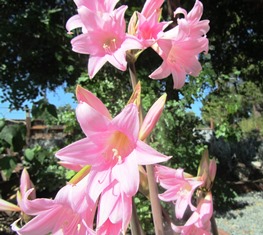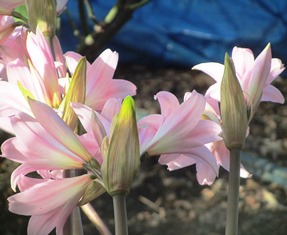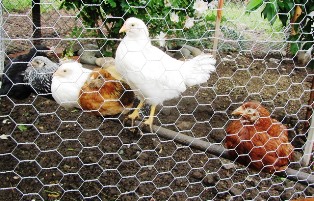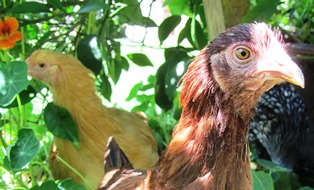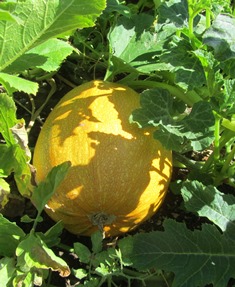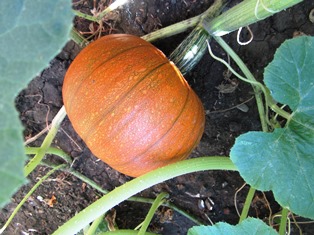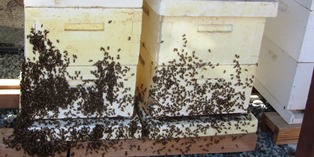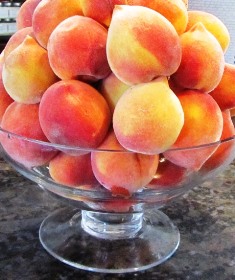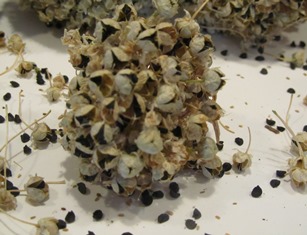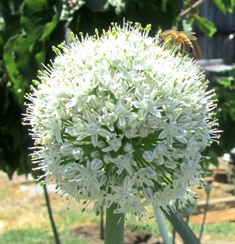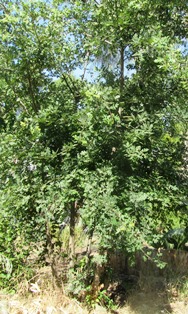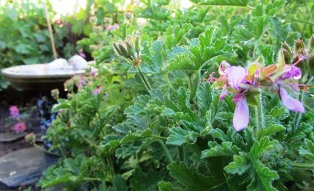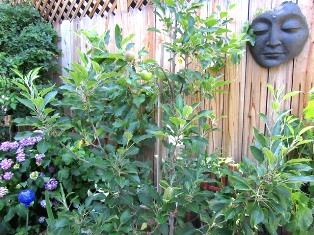Archive for the 'Plants and Trees' Category
The Four-Year Wait for a Bloom
Surprise isn’t the right word for what I felt rounding the corner today. I looked over into our rose garden and the bulbs we planted four years ago finally bloomed, sans the foliage which dried in the California heat a month or two ago.
These beautiful lilies were such a surprise. We saw the long stalks shooting upward with unopened buds on the end and wondered what they were. Then they opened to reveal these dazzling lilies.
They were likely planted in the 1950s or a decade later on the property adjacent to ours. The old man who owned the property behind ours passed away a year or so before we arrived. His daughter gave us the lily bulbs. Alas, she doesn’t seem to remember the flowers (except that there were bulbs) and we don’t know what kind they are either. They look like star lilies, and are born on 3 foot-stalks. There is a very sweet scent emitted from the center of the flower.
I’m having a devil of a time identifying them. There are so many types of lilies, including calla lilies, trumpet lilies, oriental lilies, and day lilies, to name a few. So if you know which cultivar they belong to, please email me at Meeralester1@Gmail.com.
Gunshot Triggers Howls and Cackles in the Hood
Farm life isn’t always quiet. Night before last, a shot rang out around 11:00 p.m. It happened after some people in the neighborhood had engaged in a running argument, lasting hours.
My husband and I heard the arguing during our romantic dinner on the patio. His birthday is tomorrow and we celebrate birthdays all week, you see.
Hubby said he knew the sound of gunshots when he heard them. He was even more certain he’d heard the words, “We got to get out of here!” I was tempted to dive under the bed because people on the run with guns . . . well, that could be dangerous.
In the dark, you don’t know what has happened. I write mysteries. I’m thinking, “is there a body on the adjacent property?”
Three uniformed police officers arrive with nightsticks in their duty belts and guns in their holsters. With their flashlights drawn and turned on, they searched for a way into fortress that the neighbor has built or a means to see behind the tarps the neighbor has strung to hide his backyard and sheds.
Over the barking of the neighbor’s pit bull, I heard one officer tell the others, “This is like the Beverly Hillbillies. We’re notifying Code Enforcement.”
Glad it wasn’t our place they were talking about. We’ve been renovating . . . but neatly. Still, there’s the unfinished porch, the pile of lumber . . . .
I watched the erratic beams of their flashlights as they searched. Then . . . here they come, lights bobbing, down our driveway. They want to see if they can penetrate the fortress of the Beverly Hillbillies from another direction. Our house is in close proximity.
My husband went searching for a ladder. Call me silly, but I thought it would be the tall, thin officer, who would climb up. No, that would be too logical. It was the short, chunky one scaling into the heights, disappearing into the elm tree. Did I mention the tree has an almost impenetrable canopy in summer? Not surprising that he couldn’t see anything.
The officers decided on a look-see from the rear. My hubby guided them through a field, past the apiary and chicken house.
Roosting chickens are usually quiet. No doubt, you’ve heard the expression, “Going to bed with the chickens, rising with the rooster.” To say my hens were alarmed might be an understatement. They’d been roused from their slumber and cackled like there was no tomorrow. I realize there’s a bit of irony in the fact that our place is called the Henny Penny Farmette after Chicken Little’s story about the acorn falling on her head. This could have been the sky falling. They cackled like it was.
The deafening cackles agitated the neighbor’s pit bull, whose incessant barking got all the dogs in the hood howling. A fire engine shot by, sirens blaring. I took an aspirin, waited for my husband to return and the officers to leave.
Back in bed, who could sleep? I worried about when about when Code Enforcement might show up to cite the Beverly Hillbillies. Would the officers look over the fence and cite us as well? Code Enforcement aside, a gun-toter could hide behind our pile of porch lumber. We gotta get that porch finished.
But, like I said, it’s my husband’s birthday. He’s feeling romantic this week and not easily pushed. See my conundrum?
Get Ready for Blackberry Season
Southwest of the farmette lie the Santa Cruz mountains where blackberries grow wild. I know because I lived in those mountains and for many years hiked the environs of the mountain towns of Ben Lomond, Boulder Creek, Felton.
Nestle in the foothills, Los Gatos maintains Vasona Park where blackberries grow wild along the hiking/biking trail near a creek. I’ve been there several times this summer. Invariably, when I walk the trail in August or September and taste a ripe, freshly-picked blackberry, the sweetness and sprightly flavor evoke happy memories of summers past.
Our Henny Penny Farmette is located an hour and a half north of the Santa Cruz Mountains. Here we are situated in the shadow of Mount Diablo, but we have the kind of climate blackberries love. What is lacking is ample water that the plants need to thrive.
Blackberries require a deep soil and here we have clay (which can suffocate the berries because of the lack of good drainage the roots need). But we’ve helped the berries along by aerating and amending the soil with nutrients and with ground corn cob, aged horse manure, and compost.
Our trailing blackberries grow supported on a trellis. Use a two-wire trellis to avoid bending the canes too severely and to enable intertwining of the canes.
Last year, we planted a few of the semi-erect thornless berry vines. The Evergreen and Thornless Evergreen are commercial varieties and are extremely productive. The berries are large, black, firm, and sweet, pretty much perfect for eating out of your hand or using in a cobbler or pie. You can also make jam with blackberries alone or in combination with other fruits.
Some varieties can be so prodigious and hardy, adapting to the wild, that they are considered in some states and counties as noxious weeds, or pests. One species is the Himalaya cultivar. Its berries are shiny, black, about 1-inch long and the vines produce fruit with medium to large seeds. It quickly spreads and is difficult to control and eradicate.
The season for ripened blackberries is still a few weeks away, but watch for vines in the wild or plant some in your garden. Fall to spring is the best time for planting most berries.
Check with your local garden center for the right time to plant in your garden zone. Blackberries are perennial so the roots survive for many years, especially if the soil is loamy, well drained, and located in full sun to partial shade. For more information, see http://www.weeksberry.com/berryfiles/files/Blackberry.pdf.
Butternut Squash and French Sugar Pumpkins Takes Over the Garden
My organic vegetable garden is a mess of vines. Among the varieties of heirloom tomatoes, Armenian cucumber, summer squash, and eggplant that I planted in late spring, I also tucked in my favorite Butternut squash and French sugar pumpkins. The vines, although producing prolifically, have taken over. I can hardly get in to pick the tomatoes and I can’t see my chickens for the vines.
Next year, I’m going to try Bush Buttercup from Baker Creek Heirloom Seeds. The squash has the same orange flesh and firm rind but grows on bushy plants that say compact and grow between three and four feet high. The fruits weigh three to four pounds.
And maybe, with permission of my neighbor who has a large growing area adjoining our property I might plant Boston Marrow (first documented in 1831). That orange-fleshed squash can weigh up to 15 pounds. A native American tribe distributed the seed to settlers in New York and from there, the seed went to gardens in Massachusetts and spread elsewhere.
Another squash from that Baker Creek Seeds that I’d like to growl is Iran. Collected in Torbat-e-Heydariyeh, Iran in 1940 and preserved at the United States Department of Agriculture since, this is one of the loveliest of the ornamental squash. Orange color mottles its sea-foam green rind.
The pumpkins in my garden are Rouge Vif D’Etampes. I grew these with great success last year and saved the seed of this old French heirloom. A variety of seed companies carry this seed, including Baker Creek Seeds that notes it was one of the “most common pumpkins in the Central Market in Paris in the 1880’s . . . can be picked small and fried.”I like this one especially for pie making.
Squash and pumpkins taste great in Italian, Mexican, French, Middle Eastern, and American recipes. Rich in flavor and nutrients, squash and pumpkins can be made into soups, breads, mixed-vegetable dishes, and pies or can be baked, boiled, steamed, or fried. Even the blossoms are edible. So, it should be apparent why I need more room in my garden. Now to figure out how to keep it orderly.
Stealing Away to Visit the County Fair
My daughter dropped by for a girl’s day out at the county fair. Summer chores are endless so taking a day off riddled me with guilt–and guilty pleasure.
We strolled under ancient, white bark sycamore trees that towered 50 to 100 feet above us. The first thing we saw as we entered the arched fair-grounds gate were goat pens. The cute little milking goats drew us over, but the odor of mounds of fresh horse manure turned us away. We kept on walking.
We moseyed over to see the sheep with their docked tails (apparently sheep like to chew on the tails of other sheep, so docking the tails eliminates pain and suffering and is more hygienic). We thought the baby goats were adorable. We marveled at how the pigs appeared so pink, healthy and robust. We couldn’t help but stare at the massive bellies and large bags of the dairy cows.
Embarking on the path to the exhibit halls, we relished how cool it was inside, a veritable respite from the heat. We strolled down aisles of quilts, art by high school students, and displays of jewelry. Then it was time to check out the jams. The entries of strawberry dominated the competition, but some included jam made with fig, plum, or rhubarb.
During the dessert competition, pies, brownies, and cakes beckoned us to peer into the glass display shelves. My daughter lamented that she wished they were for sale, reminding us it was time to eat.
We passed on the roasted corn on the cob and cotton candy, choosing simple tacos and Pennsylvania Dutch-style funnel cakes. I washed my meal down with the hibiscus-flavored drink sitting next to a dispenser of white horchata while my daughter stuck with water.
Before we left the exhibit halls and animals, I wanted to see the chickens. That competition must have happened on a different day, so I wandered over to the peacock pens next to the pigeons, finches, and parakeets. The peacocks were lovely but there were no peahens.
We checked out the bunny cages (I didn’t know there were so many kinds of rabbits) and decided against even looking at the reptiles (I tend to dream about them once I see them–and snake dreams aren’t usually pleasant).
All that walking and sensory stimuli wore me out. By the time we arrived home in the late afternoon, I needed a nap. I thought a day off was supposed to rejuvenate you. Instead, mine had done me in, but the trip to the fair gave me gobs of ideas for my cozy mystery series.
Puzzling through a Cozy, Weeping at a Memoir, and Forgetting the Peach Pie
I couldn’t breathe in yesterday’s heat. But with so much work to be done around the farmette, I soldiered on, staking heirloom blue tomatoes. I hadn’t finished canning my organic apricots and now the plums and peaches were ready. I felt overwhelmed and longing for cool spot to sip tea, rest, and read.
We had already removed the apricots from our “torture tree” since we’ve been unable to surmount its many problems after planting it five years ago. Carlos wasted little time chain-sawing it down. I deadheaded the roses, while he dug out the stump.
Then with a clear view to our hives, we quickly realized that the we needed to suit up and install extenders or the bees would swarm. Even as we felt the urgency, we realized there were also dozens of other chores screaming for our attention.
I told myself that breezes would soon blow inland from the Carquinez Strait, a channel of the San Francisco Bay where the San Joaquin and the Sacramento Rivers flow to the ocean, but by mid-afternoon, nary a leaf moved on the apricot, plum, and pomegranate trees. By four o’clock when the wind finally did kick in–the air wasn’t cool as it usually was. The winds blew strong and stifling hot and threatened to suffocate anyone still working outside.
Abandoning the outside chores, I retreated indoors and turned on the air conditioner. Seeing the lug of apricots and crock of peaches resting on the kitchen counter, I groaned. The jam had to be made, but I couldn’t face stirring boiling fruit on a hot stove.
Deciding to use up some of the fruit for a simple after-dinner dessert, I flipped through the pages of a few cookbooks. Maybe a cobbler would do or a peach pie. I really didn’t need a recipe for those, but in Country Cooking by Dori Sanders, I found an intriguing raisin-cinnamon crust that sounded tasty. I bet it would go with peaches but I probably could have baked it on the patio floor.
With a glass of sweet tea and an armload of paperbacks and hardcovers, I curled up on the couch and finished reading Murder is Binding, Lorna Barrett’s debut book in her cozy Booktown Mystery series. I love this author and her writing, but soon figured out who done it. Still, I read to the end; you never know when a clever twist might show up.
Next, I read the last few pages of A Tuscan Childhood by Kinta Beevor. At bedtime, I’d been savoring the chapters of that book like pieces of rich, dark chocolate. Beevor’s evocative descriptions of her bohemian childhood in Tuscany captured my imagination, drawing me in so completely I could almost smell the wild thyme, pine needles, and rocky Tuscan terrain in the searing, summer heat. Like Frances Mayes (Under the Tuscan Sun), who wrote a quote for the cover, I felt sad when Beevor’s lovely memoir ended.
Returning to the stack, I selected another memoir, The Orchard, by Theresa Weir. I’d bought the book on impulse during a trip to the farmers’ market at Todos Santos Plaza, our downtown green space surrounded by bars and banks and, of course, a second-hand bookstore. Drastically marked down, the book had been summarily deposited on a set of moveable shelves, and rolled outside the storefront for a quick sale.
The artist and writer in me understood immediately why I had picked it up and purchased it: the cover art pictured a young couple in a loving embrace, standing in lush green grass surrounded by apple trees. But there was something in that image that evoked sadness, like a bittersweet dream of a time past, viewed through a long lens.
As the descendant of five generations of farmers, I suspected Weir’s book would resonate with my own experiences of farm life in America’s heartland with bone-chilling winters of snow and ice and sweltering summers when you prayed for rain. What I didn’t expect was exquisite writing and the juxtaposition of love against the deadly realities of widespread pesticide use on the farms that ushered me into her story and swept me along. I finished that book in one sitting and will long be haunted by it.
I felt guilty for having only paid pennies for Weir’s book. A pittance for a tale that evolved out of all she had lived through. Less than the price of bus fare to journey with her as she pieced together scenes from her life in the Heartland. In every page, I was with her as she struggled, never abandoning her dreams. She learned as I had how to tuck them away while you dealt with the realities of a hard life with heart-breaking lows and highs that reached euphoria. But there were scenes she left out, only hinting at experiences she said she would “never talk about.” The truth is, I wept after putting down her book.
When a reader identifies so closely with a character in a story (and this was Weir’s personal narrative of her life), he or she rides the emotional ups and downs with that character. Good writers understand how to tug at their readers’ emotions and milk the drama. Theresa Weir had skillfully threaded a leitmotif of darkness and light, joy and sorrow, pain and healing through her story, but never once did I feel manipulated. Every sentence of The Orchard rang true.
I couldn’t read anymore after putting that book down. As I made dinner, I thought of how many scenes in her life resonated with mine. Even the widespread pesticide use on farms and the stubbornness of farmers to change.
I thought about Rachel Carson’s famous book, Silent Spring, that sounded the wake-up call to farmers everywhere about the dangers of chemicals in fertilizers, pesticides, and herbicides. So many small farms have been overtaken by agribusinesses these days and still the chemicals are used. I decided to forgo making the peach pie.
With the heat of the day gone, I opened the windows and stretched out between freshly washed sheets. I listened to the rustle of oak and eucalyptus leaves. To crickets and the unseen critters that make noises in the night. I listened to the soft voices of my Lebanese neighbors chatting in their orchard with relatives.
As dreams beckoned, I could almost smell the fresh lilacs that Theresa Weir had written about in her memoir. Their cloying scent had filled her grandmother’s kitchen just as they had filled my grandmother’s, my mother’s, and mine. I wondered if the lilacs would ever disappear or if the world would one day wake up to find the honeybees gone, the fruit trees without fruit, and the berries and other sweet produce in our gardens and orchards reduced to a memory.
Harvesting Seeds from Onion Heads
The red and yellow onions I planted during winter here on the farmette have produced lots of fat bulbs. Now that warm weather has arrived, the plants have sent up spikes with a flower head in a process called bolting.
I’ve been using the onions in culinary creations. Now that they are bolting, I’m saving the seed heads for my next round of planting (when the weather gets cooler again).
When the seed heads I’ve collected have dried a bit, black seeds will spill out. I shake them onto paper and then store them in paper envelopes where they can dry out even more.
The benefits of growing onions from seed rather than sets (also called seedlings) is that they perform better, are less susceptible to disease, bulb up somewhat quicker than seedlings, and store better. The seeds germinate quickly (7 to 10 days) and may be eaten in as early as 8 to 10 weeks.
Growing onions is easy. Broadcast your seed in a prepared bed when the weather is warm and all danger of frost has passed. Barely cover with soil (roughly 1/4 inch) and keep damp until seeds have germinated. If you prefer, start some onion seeds in flats to set out in the garden as seedlings.
Harvest bulbs throughout the growing season or wait until the tops flop over. Store onions in the refrigerator in a nylon stocking wrapped individually between onions to maintain freshness. The National Gardening Association has some good tips for harvesting and storing onions. See http://www.garden.org/foodguide/browse/veggie/onions_harvesting/501.
With so many onion types from which to choose, decide how you’ll use each in the kitchen and then grow various heirloom types, depending on purpose and flavor. And . . . don’t worry if next spring, you discover your onions bolting. It’s a good thing to have a seed source for such an important kitchen staple.
Germinating Seeds
On the property behind my farmette, a Sierra Live Oak tree drops acorns in abundance. The acorns sprout into seedlings, ensuring new generation of the tree.
The life cycle of the oak tree begins with acorn (the seed of the oak). As with all seeds, the acorn contains the genetic information for germinating and growing into the specific type of plant (in this case, a Sierra Live Oak).
This is the secret of seeds, they are alive and many remain viable, able to germinate for 1-5 years. Seeds link one generation of a plant to the next. Seeds for woodlands as well as vegetable and flower gardens widely vary in size, shape, color, and the amount of time it takes for germination.
Seeds require moisture and warmth to germinate. Some–such as the flower garden varieties of columbine, petunia, begonia, and snapdragon–also require light to germinate. You would not plant those seeds under the soil, but rather scatter them on top of moistened soil or seed-starting mix.
Light, however, is not necessary for most seeds to germinate. Outside in the garden, seeds require soil and air temperatures to be warm (tomatoes need the ground’s night-time temperatures to be around 55 degrees Fahrenheit) before they’ll set up blossoms and fruit. Moisture is a requirement, too, but too much water destroys the seed.
Pre-sprouting is the process of sprouting seeds before they are planted in their permanent places in the garden. In cold climates, pre-sprouting can give plants (especially the heat lovers like tomatoes, peppers, and eggplant) a jumpstart in the spring since they are started indoors and put out when the warm days arrive.
Seed sown directly into the earth can take a week or more to germinate but seed pre-sprouted in your kitchen may take only a couple of days.
To sprout your seeds indoors, you’ll need to sprinkle them across a moistened (not dripping wet) paper towel and also cover them with moist paper towel. When inserted inside an unsealed plastic bag and placed in a warm area, your paper towel seed mat retains its moisture. Check it every day and spritz with water if necessary until the seeds germinate.
The small plants of germinated seeds that have not yet been planted into the garden are called seedlings. Plants in cells (like the seed flats you see in nurseries) need to have two to four sets of leaves before they are ready to transplant into the garden.
Gardening becomes a fulfilling hobby when you start plants for your garden from seed and nurture the seed through the process of germination into seedlings. Flats of cell packs (usually six or eight cells to one pack) and commercially prepared potting/planting mixtures make starting seeds for your garden fuss-free and easy.
Scented Geranium Leaves for the Garden and the Kitchen
Like the British monarch Queen Victoria, I am a lover of Pelargoniums, popularly called scented geraniums. Tucked in between a hedge of French perfume lavender, hydrangeas, and purple bearded iris in my garden is a rose-scented geranium with tiny pink flowers. I started it from a slip off my Lebanese-American neighbor’s plant and now it’s as large as a wine barrel. The varieties I grow aren’t just relegated to my garden; I have some in pots, within easy reach for culinary purposes.
My favorite, however, is the rose geranium. If I happen to brush against the leaves, the plant releases a heady perfume that scents the whole area like an old rose garden. Scented geraniums are actually unrelated to the true geranium of woodland habitat. The scented geraniums are of the genus Pelargonium, beloved of the Victorians, their monarch, my grandmother, and gardeners like me.
Indigenous to South Africa, the scented-leaf geraniums are half-hardy perennials in many parts of the United States. Once so popular there were 250 varieties or more, the plant fell out of favor after the Great War. Today’s gardener will find scents such as apple, apricot, chocolate, cinnamon, coconut, ginger, lemon, lime, mint, nutmeg, orange, pepper, pineapple, rose and strawberry, to name a few.
The leaves run the gamut of shapes, from deeply cut angles to round shapes that appear crinkled. Some leaves are smooth while others are leathery or velvety. The colors range from intense shades of green and yellowish-green to a reddish-purple hue. The lemon-scented Pelargonium crispum has small, green, crinkled leaves, for example, but the Pelargonium tomentosum features large and velvety leaves of a green-gray hue and yield a peppermint scent.
They need sun and a well-drained, slightly acidic soil. To propagate, take cuttings before the plant flowers. Keep the cuttings in water until roots form or put them in a planting mixture and keep moist until new leaves spr0ut.
Easy to grow, delightfully scented, with pretty little leaves and flowers, scented geraniums were beloved by our grandmothers and theirs before them. In any garden, they lend a generous helping of old-fashion charm. Plus, many of them can be used in homemade soaps and cosmetics. Cooks like them for their culinary uses as a scent source for sugars, or for tea, or as garnishes for cakes and salads and fruit dishes.
The process of making a scented sugar for tea or icing is quite simple. You’ll need a cup of sugar and a cup of leaves from a scented geranium. Try rose, lemon, or mint.
1. Gather a cupful of leaves
2. Thoroughly wash and dry the leaves.
3. Using one cup of sugar, alternate layers of 1 inch of sugar and a layer of leaves (some chefs say to slightly bruise to release more flavor).
4. Tightly screw the lid onto the jar.
5. Store in a warm place for 2 to 4 weeks
6. Remove the leaves (try sifting the sugar in a bowl to get all the leaves out)
7. Re-jar the scented sugar and use as needed.
Creating Sacred Space in Tandem with Nature
One of the first things I did after buying the farmette was to create a space to sit, rest, pray, and dream. Basically what I had to work with was an empty field with a tiny farmhouse in the middle. The house was a construction zone–not quiet and peaceful or nourishing to the spirit–so I need to create an outdoor sacred place for my sanity.
On the north/cool side of the house, my husband and I reinforced the fence and then planted some climbing roses, Japanese maples, hydrangeas, calla lilies, and irises. To anchor the space, we added a Cox Orange Pippin apple (a sweet dessert apple first grown at Colnbrook, Buckinghamshire, England, 1825).
Later, when I found the meditation mask, I decided to hang it on the fence, moving in a bench opposite (now my favorite place to read). A brick walkway leads to an arch that supports two Cecile Brunner climbing roses, opulently covered in tiny pink rosettes each spring. A blue reflecting ball offers a soft splash of cool color against the hydrangea pink florets. Finally, we tucked in blue-blooming dwarf agapanthus (Peter Pan) and fuchsia geraniums to give the space lushness and some cool, refreshing color.
There are many such places on our property that I’ve claimed as sacred space, but this one is my favorite. We redid the windows on the house’s north side so that the largest one looks out from our dining/living room onto this garden space. A fountain with soft gurgling water adds to the tranquility.
Besides art and possibly a water feature for your sacred space, you’ll want to think about the plants (tall, mid-size, and small), herbs, trees, climbing vines, and roses. I chose plants that I associate with my grandmother’s garden and the various gardens my mother created.
You don’t need a farmette to create sacred space. Rock gardens and arid landscapes, rooftop gardens, and cityscape corners and alleyways can be transformed as well. Work with the natural setting around you. Just stay in tune with what speaks to your spirit, gives ease to your heart, and restores peace to your mind as you create your sacred space.
 Facebook
Facebook Goodreads
Goodreads LinkedIn
LinkedIn Meera Lester
Meera Lester Twitter
Twitter



